Robert Papp
-
- Interview: Admiral Papp - Changing the Discussion Maritime Logistics Professional, Q2 2013 #20
U.S. Coast Guard Commandant Robert Papp takes (another) round turn.
Almost three years since assuming command of the United States Coast Guard, Admiral Robert Papp still insists that his service will not be focusing on additional changes – not under his command. The reshuffling of organizational deckchairs, moves towards one side of the mission to another or any other changes to how the Coast Guard operates, are a thing of the past. But, are they really? An April visit with the Commandant, our first in two years, revealed that if the mantra stayed the same, some of the underlying action did not. That’s not to say the Coast Guard is any less ready to respond to security threats or to natural or manmade disasters. What it does mean is that Papp has quietly set the service on a course that values both sides of the Coast Guard mission sets – prevention and response – on equal footing. Along the way, a subtle shift in Arctic strategy has also emerged. Some of that is a function of the ongoing budget battles. The rest, refreshingly, is a new thought process on what’s possible, what’s absolutely necessary and a different way to get it all done. The last part is all Papp.
Change
Papp begins by saying simply, “We are not going to focus on any more changes. We are going to focus on improving ours processes. And lock these down.” The key to improving the Coast Guard, he said, lies in modernizing the support side of the equation – the engineers, the logisticians, the comptrollers. During the steep cuts of the 1990’s, that group had withered away. “That’s why we failed at Deepwater so miserably – we lost our acquisition expertise because we cut the support side. We failed our audit and so we took the support side improvements that had been started under Admiral Allen and we locked that down. We now have a deputy commandant for mission support. What we’ve come up with is a new, responsive, accountable support system.”
Culture
Papp talks about external events that, in his words, involve “the pendulum that would swing from one side to the other; depending on what the most recent crisis entailed.” The Exxon Valdez oil spill and the push towards oil spill response, as well as the terrorist attacks of September 11 which necessitated a heavily weighted emphasis to the security aspect of Coast Guard operations are perfect examples. “Some people make the case – the marine industry, in fact – that we had lost our focus on regulatory procedure and inspection. They were right about that and we have brought that back along.”
Papp also makes reference to the emergence of what he characterizes as “separate and distinct cultures – some would call them silos – within the Coast Guard.” The silos, he insists, only separate the wide range of missions. “What I have tried to do is help the service understand how and why all of these cultures must integrate in order for the Coast Guard to be successful in all of our missions.”
Papp cites the four missions that came together to form today’s Coast Guard – the revenue cutter service, the lifesaving service, the lighthouse service and the bureau of marine inspection. “We were integrated to give better return on investment to the American people. Buoy tenders are often called upon to break ice or do migrant operations or fishery patrols. If you lose the lighthouse service, for example, you lose that economy of scale.”
Prevention
Recalling his proudest moment(s) as Commandant, Papp without hesitation mentions the response to hurricane Sandy. Recognizing those who had flown out and recovered the 14 survivors from the Bounty, and without taking anything away from the heroic rescue itself, he also says, “It dawned on me that those 14 people may have not been saved if Coast Guard regulations did not require them to have survival suits, liferafts or require mariners to be licensed and trained. Those things are just as important as the people who go out into the middle of the night to rescue them.” Furthermore, he said, “The better that we do these prevention/regulatory activities, the less frequently we have to send people out into dangerous situations.”
With regard to the Coast Guard’s regulatory missions, Papp says flatly, “I find this fascinating. As a ship operator, I wasn’t involved in this aspect of our missions for most of my career. But, these regulations are so important to what we do. It’s not supposed to be fast. The only thing I’ve ever seen go rapidly was security in the wake of 9/11. Some people would say we didn’t get some things right and if so, that’s a function of the speed of that process. We’ve brought more people in to the regulatory process, but more importantly, we are training them. And, we’ve brought our average time span for the regulatory process down from six to four years. We need to listen to everyone and make compromises where necessary. That, by its nature cannot always be speedy. Papp also admits that the consolidation of the Regional Exam Centers to West Virginia to gain efficiencies was a good idea, but that it took too much away from the regional offices. “You still need to have a face out there that people can deal with,” he said, but also insisted, “From my experience, credentialing experiences that I hear about have been more positive and indeed mostly positive.”
The Arctic
Admiral Papp has his own approach to the Coast Guard’s Arctic responsibilities. The Commandant is, if not happy, satisfied that he has done what he can. He freely admits that it is more than he had hoped to accomplish when he took command some three years ago. A new Arctic strategy is now in play – now sitting on DHS Secretary Janet Napolitano’s desk, awaiting action. It is here where Papp diverges from past policy.
”The previous study said: you need ‘X’ number of medium and heavy breakers. It is an objective, but we are so far from the objective that it really doesn’t matter. What we need to do is to get a comprehensive national strategy in the Arctic right now. The Coast Guard is going to lead on this. You have to have a strategy before you ask for resources to get the job done. We’ll start getting some other agencies involved, but for me to ask for icebreakers – that won’t get traction – not until we as a nation decide what we want.”
Papp’s strategy involves measurable goals. “We set the initial goal of getting the Polar Star reactivated. After operational testing, we expect to send Polar Star up to the Arctic sometime early summer while there is still some decent ice up there. After that, we’ve committed to the National Science Foundation to break out Macmurdo in Antarctica.” Along with this, Papp’s wish list included getting the icebreaker money put back into the Coast Guard’s budget (done!) and to make the case for a new icebreaker. “Maybe I set my goals too modestly. The President in the new FY-13 budget approved funds for the design and requirements for the new icebreaker. Congress is now requiring us to do a business analysis to see what can be done with Polar Sea – which we intended to decommission and use for parts. They want to know if it is feasible and economical to activate it. We’re trying to determine that now.”
According to Papp, the nation needs assured access to assert sovereignty in Arctic waters. But, he says, “Everybody says you have to have icebreakers and (yes) you have to have them when you need access, but human activity only occurs when the ice recedes. You don’t need a single mission hull, you need the national security cutter. This is the optimal resource for conducting operations, because we don’t have shore infrastructure up there. You’ve got a command center on the national security cutter that is superior to any shoreside center and you also have an air station. And you’ve got three boats and crew and all the command and control capabilities that goes along with it.”
What Papp is unwilling to do is to build Arctic shoreside infrastructure because it is expensive to build and there is not yet any national consensus on the way forward. In the meantime, the Coast Guard will do what it has always done best. “We have mobile, versatile assets that we can move around when the mission is there. The oil companies aren’t going up there until ice recedes, nor are the cruise ships. That’s when we need search and rescue, pollution response, security type operations. There’s going to be winter ice up there for the foreseeable future. That gives us a couple of decades to do seasonal operations and continue to learn and make plans for permanent infrastructure.”
The “S” Word
There isn’t anything vague about Bob Papp’s policy when it comes to dealing with sequestration. Papp says simply, “We want to maintain our capability to respond to mission priorities. I have designated those as search and rescue and security operations.” Pressed on what specific missions he might have to cut first, he responded flatly, “I don’t know and I don’t want to advertise to adversaries where we may or may not be putting resources. For instance, if Haitians know there are no Coast Guard cutters out there, we may see more Haitians taking to the sea. To say I am cutting back on one particular mission is not wise. Beyond that, you just don’t know on a day-to-day basis what is going to happen.”
The Big Picture
Keeping the recapitalization going is the one thing that keeps Papp awake at night. “We’re hoping to get all eight of the national security cutters built. We need all eight because they are replacing 12 hulls. The new budgets include money for number 6 and lead money to start getting parts for number 7. You’ll have to wait for the FY14 budget, but I can tell you I’m happy with how that is shaping up. Not all the money to do everything I want to do as commandant, but we are getting are most important issues moving forward.” You have to like the guy. It’s all substance; no flash. In other words, the perfect guy for the Coast Guard.
(As published in the 2Q edition of Maritime Professional - www.maritimeprofessional.com)
-
- From the Editor's Desk Marine News, Feb 2014 #6
Coast Guard’s rulemaking role is anything but dormant. With as many as 68 rulemaking efforts underway as of December 31, U.S. Coast Guard Commandant ADM Robert Papp has a lot to clear off his desk before he passes the baton to his as yet unnamed successor. For example, inland stakeholders hope that the long
-
- Is the US Prepared to Protect Its Arctic Interests? Maritime Reporter, Sep 2014 #24
that presently applies to claims and resolution of conflicts in the Arctic is the Law of the Sea Convention. As then-U.S. Coast Guard Commandant ADM Robert Papp, Jr., testified before the Senate Committee on Foreign Relations at a June 12, 2012 hearing, “[t]he Coast Guard needs the Convention to ensure America’s
-
- USCG Makes Headway in Challenging Waters Maritime Reporter, Mar 2015 #48
C4ISR systems, we don’t really know what the three design will look like yet. When the contract awards were announced, then-Coast Guard Commandant Adm. Robert Papp said that The OPC program, “is the most important — not just shipbuilding — but the most important acquisition program that the Coast Guard has
-
- Budget Battles Bumping Backlogs? Marine News, May 2013 #28
FRCs measure 154’ LOA, drawing 9’ 6” in draft and have a range of 2,950 nautical miles. They can carry a crew of 24. U.S. Coast Guard Commandant Adm. Robert Papp insists that the Sentinel class is a critical asset, but Papp also said recently that getting all of the National Security Cutters built was one
-
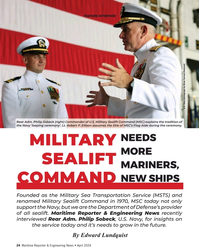 )
April 2024 - Maritime Reporter and Engineering News page: 24
)
April 2024 - Maritime Reporter and Engineering News page: 24Adm. Philip Sobeck (right) Commander of U.S. Military Sealift Command (MSC) explains the tradition of the Navy ‘looping ceremony’. Lt. Robert P. Ellison assumes the title of MSC’s Flag Aide during the ceremony. NEEDS MILITARY MORE SEALIFT MARINERS, NEW SHIPS COMMAND Founded as the Military
-
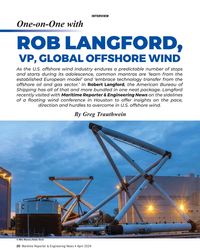 )
April 2024 - Maritime Reporter and Engineering News page: 20
)
April 2024 - Maritime Reporter and Engineering News page: 20adolescence, common mantras are ‘learn from the established European model’ and ‘embrace technology transfer from the offshore oil and gas sector.’ In Robert Langford, the American Bureau of Shipping has all of that and more bundled in one neat package. Langford recently visited with Maritime Reporter
-
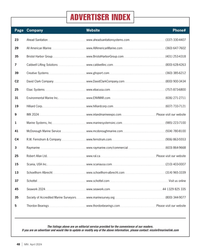 )
April 2024 - Marine News page: 48
)
April 2024 - Marine News page: 48.com (504) 780-8100 C4 R.W. Fernstrum & Company www.fernstrum.com (906) 863-5553 3 Raymarine www.raymarine.com/commercial (603) 864-9668 25 Robert Allan Ltd. www.ral.ca Please visit our website 15 Scania, USA Inc. www.scaniausa.com (210) 403-0007 13 Schoellhorn Albrecht www.schoellhorn-albrecht
-
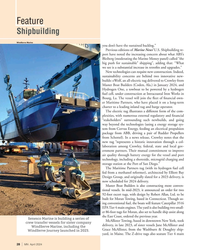 )
April 2024 - Marine News page: 28
)
April 2024 - Marine News page: 28. Master Boat Builders is also constructing more conven- tional vessels. In mid-2023, it announced an order for two 92-foot escort tugs, with design by Robert Allan, Ltd. to be built for Moran Towing, based in Connecticut. Though us- ing conventional fuel, the boats will feature Caterpillar 3516 EPA Tier
-
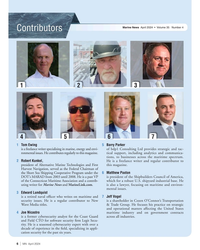 )
April 2024 - Marine News page: 6
)
April 2024 - Marine News page: 6issues. He contributes regularly to this magazine. tical support, including analytics and communica- tions, to businesses across the maritime spectrum. 2 Robert Kunkel, He is a freelance writer and regular contributor to president of Alternative Marine Technologies and First this magazine. Harvest Navigation
-
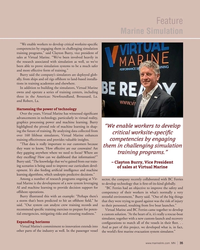 )
February 2024 - Marine News page: 35
)
February 2024 - Marine News page: 35building the simulators, Virtual Marine owns and operate a series of training centers, including three in the Americas: Newfoundland, Broussard, La. and Robert, La. Harnessing the power of technology Over the years, Virtual Marine has witnessed signi? cant advancements in technology, particularly in virtual
-
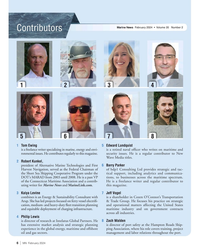 )
February 2024 - Marine News page: 6
)
February 2024 - Marine News page: 6on maritime and ronmental issues. He contributes regularly to this magazine. security issues. He is a regular contributor to New Wave Media titles. 2 Robert Kunkel, president of Alternative Marine Technologies and First 6 Barry Parker Harvest Navigation, served as the Federal Chairman of of bdp1
-
 )
November 2023 - Marine News page: 64
)
November 2023 - Marine News page: 64(906) 863-5553 53 Rhotheta International Inc www.rhothetaint.com/marine (954) 495-8700 31 Ribcraft USA LLC. www.ribcraftusa.com (781) 639-9065 41 Robert Allan Ltd. www.ral.ca Visit us online 21 Schoellhorn Albrecht www.schoellhorn-albrecht.com (314) 965-3339 29 SEATAC Marine www.seatacmarine
-
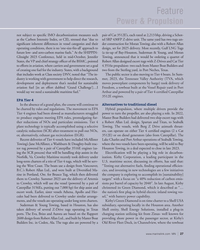 )
November 2023 - Marine News page: 27
)
November 2023 - Marine News page: 27unit. The same yard has two tugs un- signi? cant inherent differences in vessel categories and their der construction for Moran Towing; also with a Robert Allan operating conditions, there is no ‘one-size-? ts-all’ approach to design, set for 2025 delivery. Most recently, Gulf LNG Tugs future low-
-
 )
November 2023 - Marine News page: 13
)
November 2023 - Marine News page: 13.” feedback to try to develop a better product, this was all At the end of October, DMI performed sea trials for Ar- super attractive to me.” temis, a new Robert Allan Ltd. RApport 2500 tug for Br- Manning said his attention to the relationships side of usco, to be chartered by Crowley. It is also currently
-
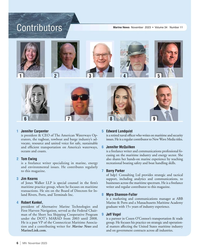 )
November 2023 - Marine News page: 6
)
November 2023 - Marine News page: 6on the Board of Directors for In- land Rivers, Ports, and Terminals Inc. 8 Myra Shannon-Fuller is a marketing and communications manager at ABB 4 Robert Kunkel, Marine & Ports and a Massachusetts Maritime Academy president of Alternative Marine Technologies and graduate with 15+ years of industry
-
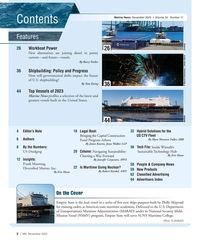 )
November 2023 - Marine News page: 2
)
November 2023 - Marine News page: 2Frank Manning, 58 People & Company News 22 Is Maritime Going Nuclear? Diversi? ed Marine, Inc. 59 New Products By Robert Kunkel, AMT By Eric Haun 62 Classi? ed Advertising 64 Advertisers Index On the Cover Empire State is the lead vessel in a series of ? ve new ships
-
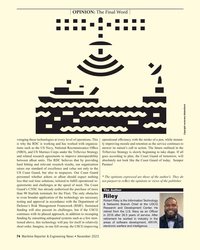 )
November 2023 - Maritime Reporter and Engineering News page: 74
)
November 2023 - Maritime Reporter and Engineering News page: 74of more The Author than 90 Starlink terminals for the Fleet. The only obstacles Riley to even broader application of the technology are necessary Robert Riley is the Information Technology testing and approval in accordance with the Department of & Networks Branch Chief at the USCG Defense’s Risk
-
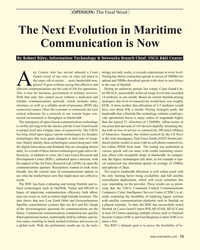 )
November 2023 - Maritime Reporter and Engineering News page: 73
)
November 2023 - Maritime Reporter and Engineering News page: 73OPINION: The Final Word The Next Evolution in Maritime Communication is Now By Robert Riley, Information Technology & Networks Branch Chief, USCG R&D Center ny Coastie who has served onboard a Coast nology not only works, it exceeds expectations at every level. Guard vessel of any size, or class can
-
 )
November 2023 - Maritime Reporter and Engineering News page: 70
)
November 2023 - Maritime Reporter and Engineering News page: 70in Türkiye are undergoing sea trials ahead of being delivered to SAAM Towage’s Canadian ? eet. The tugs are based on the ElectRA 2300SX design from Robert Allan Ltd (RAL). They were launched on April 8 and September 9 respectively, and measure 23.4m LOA, with an 11.9m beam and maximum draft of 5.5m
-
 )
November 2023 - Maritime Reporter and Engineering News page: 27
)
November 2023 - Maritime Reporter and Engineering News page: 27Maersk Godmother of Laura Mærsk, EU Commission President Ursula von der Leyen, in front of the vessel with Ane Maersk Mc-Kinney Uggla, Maersk Chair, Robert Uggla, Maersk CEO Vincent Clerc, Denmark’s Minister of Business, Morten Bodskov, President and CEO of HD Hyundai, Kisun Chung ? anked by the Captains
-
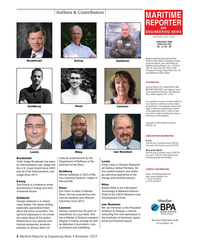 )
November 2023 - Maritime Reporter and Engineering News page: 4
)
November 2023 - Maritime Reporter and Engineering News page: 4and maritime sectors. t: (212) 477-6700 f: (212) 254-6271 Ewing MarineLMS. Tom Ewing is a freelance writer Riley specializing in energy and envi- Haun Robert Riley is the Information ronmental issues. Eric Haun is editor of Marine Technology & Networks Branch News. He has covered the com- Chief at the
-
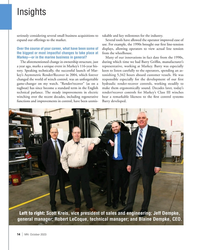 )
October 2023 - Marine News page: 14
)
October 2023 - Marine News page: 14in control, have been unmis- Barry developed. Left to right: Scott Kreis, vice president of sales and engineering; Jeff Dempke, general manager; Robert LeCoque, technical manager; and Blaine Dempke, CEO. 14 | MN October 202
-
 )
October 2023 - Marine News page: 6
)
October 2023 - Marine News page: 6, to land Rivers, Ports, and Terminals Inc. businesses across the maritime spectrum. He is a freelance writer and regular contributor to this magazine. 5 Robert Kunkel, president of Alternative Marine Technologies and First 10 Jeff Vogel Harvest Navigation, served as the Federal Chairman of is a partner
-
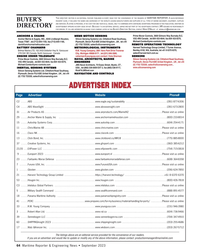 )
September 2023 - Maritime Reporter and Engineering News page: 64
)
September 2023 - Maritime Reporter and Engineering News page: 64. . . . . . . . . . . . . . . . . . . . .www.youngusa.com . . . . . . . . . . . . . . . . . . . . . . . . . . . . . . . . . . . .(231) 946-3980 3 . . . . . .Robert Allan Ltd. . . . . . . . . . . . . . . . . . . . . . . . . . . . . . . . . . . .www.ral.ca . . . . . . . . . . . . . . . . . . . . . . . . . . . .
-
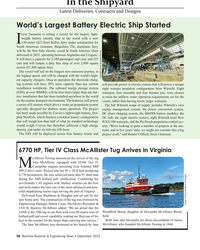 )
September 2023 - Maritime Reporter and Engineering News page: 58
)
September 2023 - Maritime Reporter and Engineering News page: 58kW hour. ment, and in ? ve years’ time, we might not consider this a big The ESS will be deployed across four battery rooms and project at all,” said Robert Clifford, Incat Chairman. 6770 HP, Tier IV Class McAllister Tug Arrives in Virginia cAllister Towing announced the arrival of the tug Jane McAllister
-
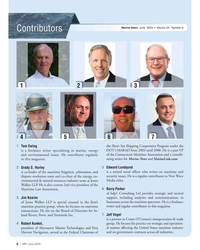 )
June 2023 - Marine News page: 6
)
June 2023 - Marine News page: 6sits on the Board of Directors for In- land Rivers, Ports, and Terminals Inc. 7 Jeff Vogel is a partner in Cozen O’Connor’s transportation & trade 4 Robert Kunkel, group. He focuses his practice on strategic and operation- president of Alternative Marine Technologies and First al matters affecting the
-
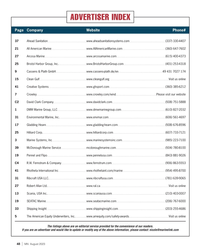 )
August 2023 - Marine News page: 48
)
August 2023 - Marine News page: 48(906) 863-5553 41 Rhotheta International Inc www.rhothetaint.com/marine (954) 495-8700 31 Ribcraft USA LLC. www.ribcraftusa.com (781) 639-9065 27 Robert Allan Ltd. www.ral.ca Visit us online 13 Scania, USA Inc. www.scaniausa.com (210) 403-0007 19 SEATAC Marine www.seatacmarine.com (206)
-
 )
August 2023 - Marine News page: 43
)
August 2023 - Marine News page: 43available at Kitimat, the har- yards in Turkey, the vessel is the ? rst in a series of three bor tugs will be able to recharge from shore charging fa- Robert Allan Ltd. designed ElectRA 2800 battery electric cilities at their berths between dockings, resulting in near- harbor tugs being constructed for
